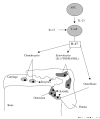The role of T-cell interleukin-17 in conducting destructive arthritis: lessons from animal models
- PMID: 15642151
- PMCID: PMC1064899
- DOI: 10.1186/ar1478
The role of T-cell interleukin-17 in conducting destructive arthritis: lessons from animal models
Abstract
Interleukin-17 (IL-17) is a T cell cytokine spontaneously produced by cultures of rheumatoid arthritis (RA) synovial membranes. High levels have been detected in the synovial fluid of patients with RA. The trigger for IL-17 is not fully identified; however, IL-23 promotes the production of IL-17 and a strong correlation between IL-15 and IL-17 levels in synovial fluid has been observed. IL-17 is a potent inducer of various cytokines such as tumor necrosis factor (TNF)-alpha, IL-1, and receptor activator of NF-kappaB ligand (RANKL). Additive or even synergistic effects with IL-1 and TNF-alpha in inducing cytokine expression and joint damage have been shown in vitro and in vivo. This review describes the role of IL-17 in the pathogenesis of destructive arthritis with a major focus on studies in vivo in arthritis models. From these studies in vivo it can be concluded that IL-17 becomes significant when T cells are a major element of the arthritis process. Moreover, IL-17 has the capacity to induce joint destruction in an IL-1-independent manner and can bypass TNF-dependent arthritis. Anti-IL-17 cytokine therapy is of interest as an additional new anti-rheumatic strategy for RA, in particular in situations in which elevated IL-17 might attenuate the response to anti-TNF/anti-IL-1 therapy.
Figures


References
-
- Yao Z, Painter SL, Fanslow WC, Ulrich D, Macduff BM, Spriggs MK, Armitage RJ. Human IL-17: a novel cytokine derived from T cells. J Immunol. 1995;155:5483–5486. - PubMed
-
- Kennedy J, Rossi DL, Zurawski SM, Vega F, Jr, Kastelein RA, Wagner JL, Hannum CH, Zlotnik A. Mouse IL-17: a cytokine preferentially expressed by αβ TCR+CD4-CD8- T cells. J Interferon Cytokine Res. 1996;16:611–617. - PubMed
-
- Rouvier E, Luciani M-F, Mattei M-G, Denizot F, Golstein P. CTLA-8, cloned from an activated T cell, bearing AU-rich messenger RNA instability sequences, and homologous to a Herpesvirus Saimiri gene. J Immunol. 1993;150:5445–5456. - PubMed
Publication types
MeSH terms
Substances
LinkOut - more resources
Full Text Sources
Other Literature Sources
Medical

